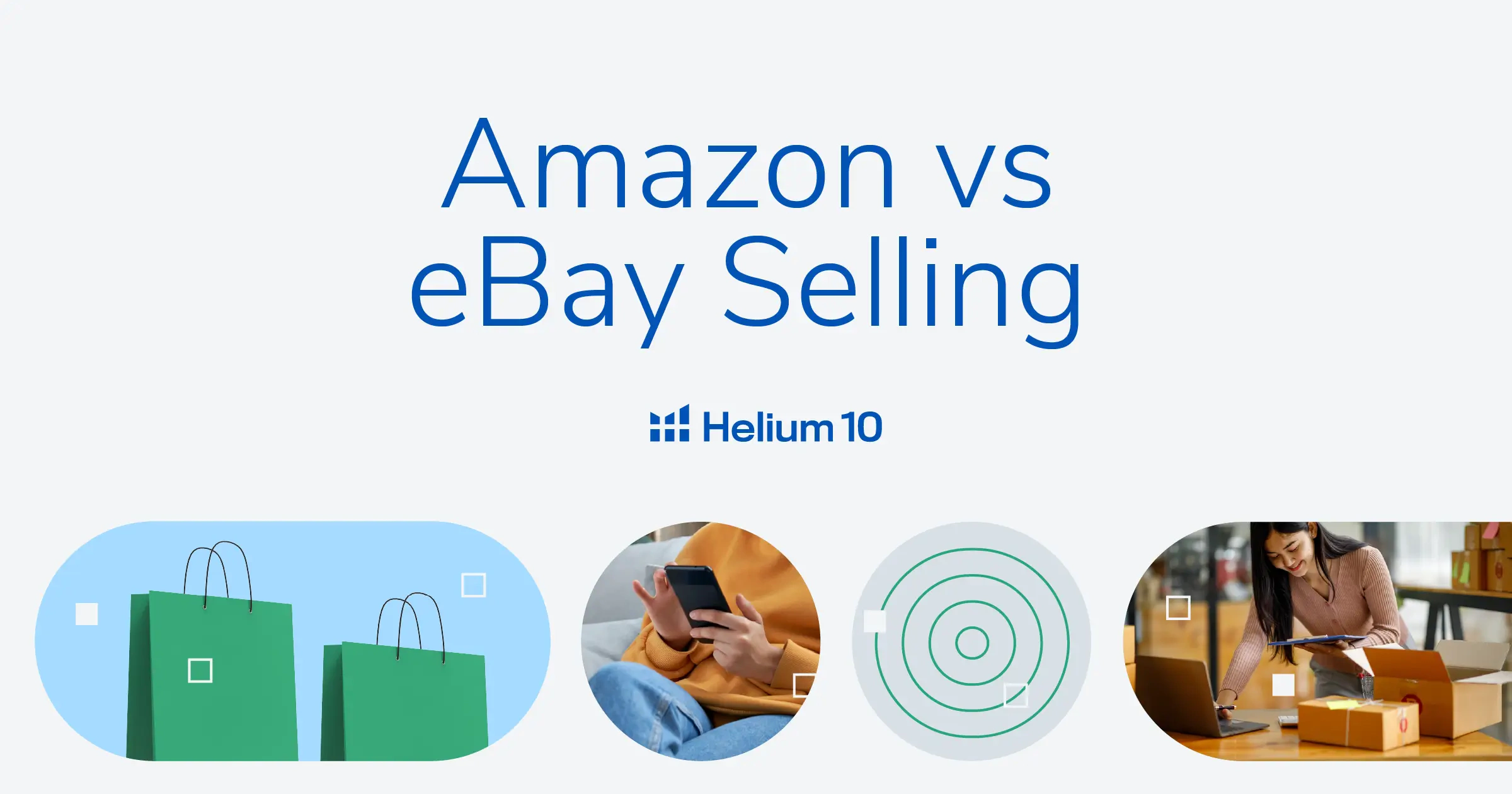
Selling On Amazon vs eBay: Which Platform Will Maximize Your Earning Potential?


Table of Contents
- Introduction
- What are the Key Differences Between Selling on Amazon and eBay?
- Fulfillment Methods
- Amazon
- eBay
- Level of Competition
- Amazon
- eBay
- Marketplaces: National & International Reach
- Amazon
- eBay
- Customer Service Requirements
- Amazon
- eBay
- Is It Cheaper to Sell on Amazon or eBay?
- Seller Fees
- Amazon
- eBay
- PPC Costs
- Amazon
- eBay
- Which Platform is Easier to Sell Through?
- Amazon Seller Central
- eBay Seller Hub
- Pros and Cons of Selling on Amazon and eBay
- Amazon
- eBay
- Why Sellers Might Consider Selling on eBay
- Conclusion
Introduction
If you were to ask someone which company has been around longer, eBay or Amazon, most would say eBay. However, eBay launched a year after Amazon did in 1995. For years, it held more market share than Amazon due to Amazon focusing on books in its early years.
I have been selling on eBay for over twenty years…way longer than I have been selling on Amazon, Walmart, and Etsy combined! These days, I do not sell much on the platform. So far this year, I have only sold about $50,000.

Outclass Your Competitors
Achieve More Results in Less Time
Maximize your results and drive success faster with Helium 10’s full suite of Amazon and Walmart solutions.
Sign Up for Free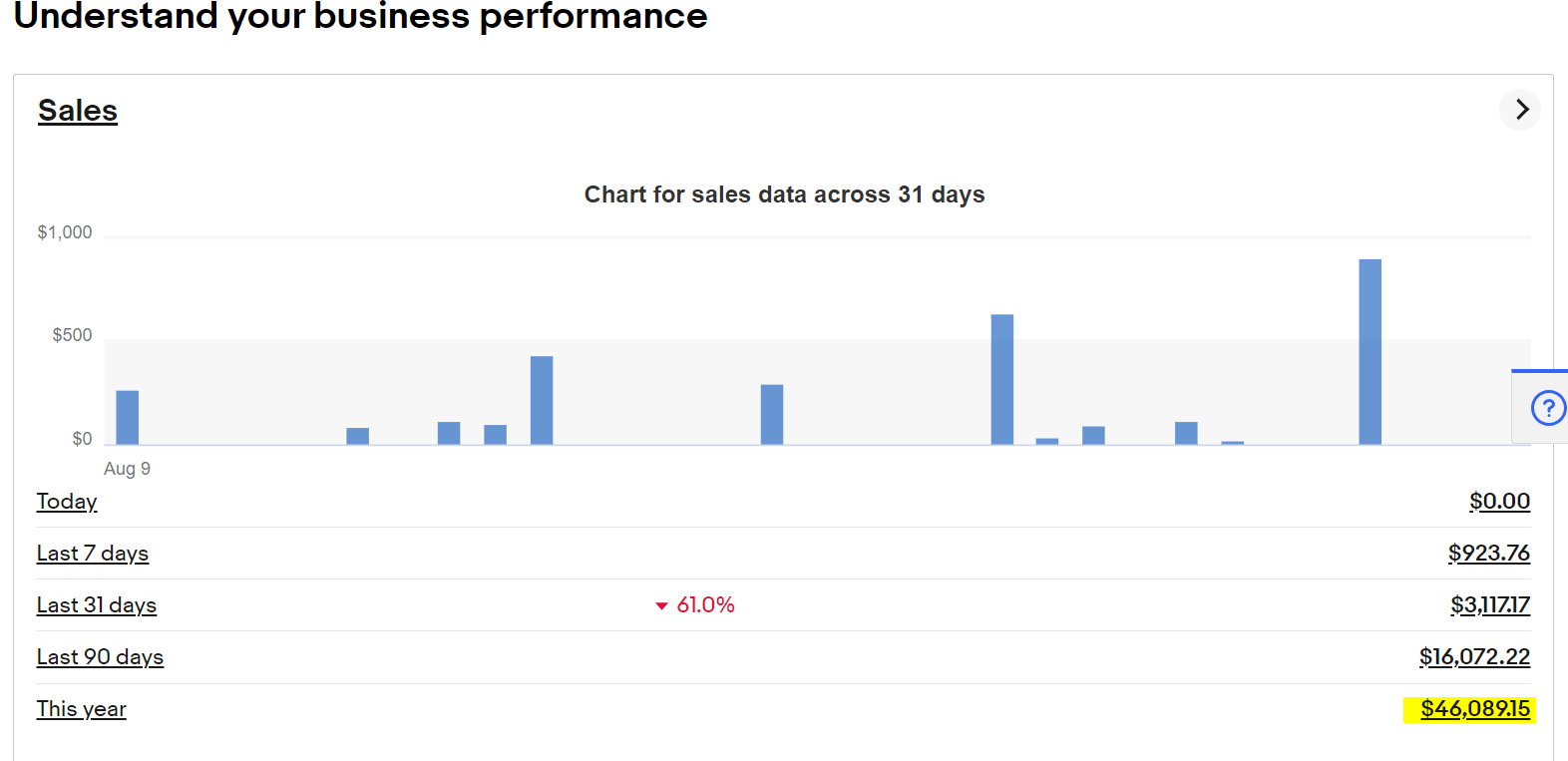
So what is the difference between selling on eBay vs Amazon? Should all Amazon sellers sell on eBay as well? How do eBay fees differ from Amazon fees? Let’s dive into the answers together!
What are the Key Differences Between Selling on Amazon and eBay?
Fulfillment Methods
Amazon
Amazon offers sellers two fulfillment methods: Fulfillment by Amazon(FBA) and Fulfillment by Merchant (FBM). Amazon FBA is a service that allows third-party sellers to store their products in Amazon’s fulfillment centers. When a customer orders a product, Amazon handles the storage, packing, shipping, and customer service on behalf of the seller. This service streamlines sellers’ entire order fulfillment process, enabling them to focus more on their business operations and growth.
FBM is where sellers handle the entire order fulfillment process rather than using Amazon’s fulfillment centers. With FBM, sellers are responsible for storing, picking, packing, shipping, and handling customer service for their products. This method offers more control over the fulfillment process but requires the seller to manage these operations independently.
eBay
When selling on eBay, eBay does not have a fulfillment service like Amazon FBA. All eBay sellers are responsible for handling the fulfillment process (or hiring a 3rd party fulfillment service to help). That means you are expected to pack and ship your items to the buyer when you sell products on eBay. eBay has partnered with UPS, FedEx, and USPS, so once you sell an item, you can purchase a shipping label through eBay Labels.
eBay does have services, though, for sending international shipments to customers who buy from overseas. The program is called eBay International Shipping. You send your product to a domestic shipping hub, where eBay consolidates orders and delivers them to international customers.
I sell sports and trading cards on eBay, some of which are very low in value. The cheapest shipping rate for USPS is normally around $4; however, eBay has a program called eBay Standard Envelope, which allows you to save up to 70% from the cheapest USPS prices to send very small, light, and inexpensive products. For example, a 2-ounce envelope will only set you back 87 cents!
Level of Competition
Amazon
The level of competition for sellers on Amazon can vary widely depending on the product category, market trends, and the seller’s niche. Amazon is a vast marketplace with millions of sellers offering diverse products, naturally leading to varying degrees of competition. Highly popular categories such as electronics, fashion, and home goods tend to have more sellers, making them more competitive.
New and trending products often attract increased competition, especially if they have the potential for high demand and profitability. Additionally, products with low barriers to entry, such as private label or generic items, can also lead to intense competition as multiple sellers vie for the same customer base.
It’s important to conduct thorough market research to gauge the level of competition in your chosen category or niche. This includes analyzing the number of sellers, their product offerings, customer reviews, and pricing strategies. While competition can be fierce, a well-defined brand, unique value proposition, and effective marketing strategies can help a seller stand out and succeed even in competitive markets. Proper keyword research will ensure that you appear higher in the search results for more keywords than your competitors.
eBay
Similar to Amazon, the level of competition for sellers on eBay varies depending on the product category, market trends, etc. The competition can be moderate to intense, depending on factors such as the category’s popularity, the product’s uniqueness, and the seller’s reputation.
Certain categories on eBay, such as electronics, fashion, and collectibles, tend to have higher competition due to their broad appeal. However, eBay’s vast customer base and global reach also mean there are opportunities for sellers to tap into niche markets and find success even in competitive categories.
To effectively navigate the competition, eBay sellers need to optimize their product listings with accurate descriptions and high-quality images, set competitive prices, and focus on building a strong seller reputation through excellent customer service and timely shipping. Building a unique brand and offering value-added services can help sellers stand out in the competitive eBay marketplace.
Marketplaces: National & International Reach
Amazon
Amazon has over 20 marketplaces worldwide that sellers can sell on, including Singapore, USA, Japan, Australia, Germany, Brazil, and many more, providing a significant advantage in reach and potential customer base. With Amazon’s vast network of marketplaces, sellers can tap into local markets in different countries, expanding their business globally. This access to diverse marketplaces allows sellers to target specific regions, languages, and customer preferences, tailoring their offerings to resonate with different cultures and markets.
Selling on international Amazon marketplaces allows sellers to reach customers they might not have been able to access otherwise. Each marketplace operates as a separate platform, yet Amazon offers tools and services to simplify cross-border selling. Through Amazon’s Global Selling program, sellers can manage inventory, logistics, and currency conversion, making it easier to navigate international markets.
Amazon’s ability to expand internationally contrasts with eBay, where sellers typically list on a single global platform. While eBay also offers international shipping options, the reach may not be as extensive as Amazon’s dedicated marketplaces. Therefore, for sellers aiming to maximize their earning potential and tap into both local and international markets, Amazon’s diverse and extensive range of national and international marketplaces can be a strategic advantage.
eBay
eBay offers sellers access to a global marketplace that spans national and international reach. Sellers on eBay can connect with buyers from various countries and regions, capitalizing on the platform’s widespread popularity. While eBay operates as a single platform rather than a distinct international marketplace like Amazon, it facilitates cross-border transactions through its Global Shipping Program and other international shipping options.
eBay still has multiple marketplaces like Amazon internationally; however, one must maintain these accounts separately as opposed to a single logon like Amazon.
Selling on eBay allows businesses to reach customers worldwide, regardless of location. Sellers can list items on their local eBay site and have them accessible to buyers worldwide. However, it’s important to note that while eBay offers international reach, the level of market penetration may vary depending on the specific country or region. Sellers should consider shipping costs, customs regulations, and competition when expanding their eBay reach internationally.
Unlike Amazon, eBay achieves its international reach through a unified platform, making it potentially simpler to manage listings and sales across countries. This setup can benefit smaller sellers looking to dip their toes into the international market without navigating multiple marketplaces. Ultimately, eBay’s approach offers a comprehensive global marketplace, making it an attractive option for sellers aiming to maximize their earning potential beyond their local market.
Customer Service Requirements
Amazon
Amazon has stringent customer service requirements for sellers to ensure a positive shopping experience for its customers. As a seller on Amazon, you’re expected to provide excellent customer service, including prompt responses to customer inquiries and fast resolution of any issues. Amazon emphasizes responsiveness and efficiency in handling customer communications. For sellers that use Amazon FBA, Amazon handles most customer service requirements for you!
Timely order fulfillment is also critical to Amazon’s customer service expectations. Sellers are required to meet specific shipping and delivery timelines to maintain high levels of customer satisfaction. This involves shipping orders within the specified time frame and ensuring accurate tracking information is provided to customers.
Furthermore, Amazon’s return and refund policies are crucial in customer service. Sellers are expected to adhere to Amazon’s standardized return policies, which aim to make returns as smooth as possible for customers. This includes providing clear return instructions and promptly processing refunds when necessary.
Meeting these customer service requirements contributes to positive customer experiences and impacts your seller metrics and overall performance on the platform. Sellers who consistently deliver exceptional customer service are more likely to earn higher ratings, better reviews, and repeat business, ultimately maximizing their earning potential on Amazon.
Because Amazon is so customer-centric, it almost always will side with the buyer if there is any dispute.
eBay
eBay strongly emphasizes providing excellent customer service to create a positive shopping experience for buyers. As a result, eBay has established certain customer service requirements that sellers are expected to meet. These requirements ensure that buyers receive timely and accurate information, efficient order processing, and satisfactory resolutions to any issues arising during the buying process. Here are some key customer service requirements that eBay has for its sellers:
- Handling Time: Sellers must specify their handling time for processing and shipping orders. This information is visible to buyers and helps set expectations for when the item will be shipped. Meeting the specified handling time is important to ensure timely order fulfillment.
- Tracking Information: Sellers are encouraged to provide tracking information for shipped orders. This allows buyers to track the progress of their shipments and helps build trust by providing transparency in the shipping process.
- Communication: Sellers are expected to communicate promptly and professionally with buyers. This includes responding promptly to buyer messages, inquiries, and concerns. Good communication can help prevent misunderstandings and build positive relationships.
- Returns and Refunds: Sellers must have a clear and well-defined return policy that specifies the conditions under which returns are accepted, the return timeframe, and whether the seller covers return shipping costs. Providing hassle-free returns can increase buyer confidence.
- Feedback and Ratings: Sellers are encouraged to maintain positive feedback and high detailed seller ratings (DSRs). Positive feedback and high DSRs indicate that sellers consistently provide good customer service and product quality.
- Resolution of Issues: Sellers should proactively address any issues or problems that buyers encounter, such as items not being received or not being described. Resolving issues promptly and fairly can help prevent negative feedback and encourage repeat business.
- eBay Money Back Guarantee: Sellers are expected to comply with eBay’s Money Back Guarantee policy, ensuring that buyers receive the item they ordered or a refund. Sellers should work with buyers to resolve any issues before involving eBay.
- eBay’s Seller Performance Standards: eBay has established specific performance standards that sellers must meet. These standards cover on-time shipping, tracking information upload, and low cases of items not as described. Falling below these standards can result in account limitations or restrictions.
Unlike Amazon, I have found that eBay usually sides with the sellers in disputes, where the customer is trying to scam the seller. (as opposed to what happens on Amazon). For example, on Amazon, if a buyer changes their mind on a product, sometimes even outside the return window, Amazon will grant the return. I had that exact thing happen to me on eBay; however, without contacting me, eBay took care of the issue and denied the request!
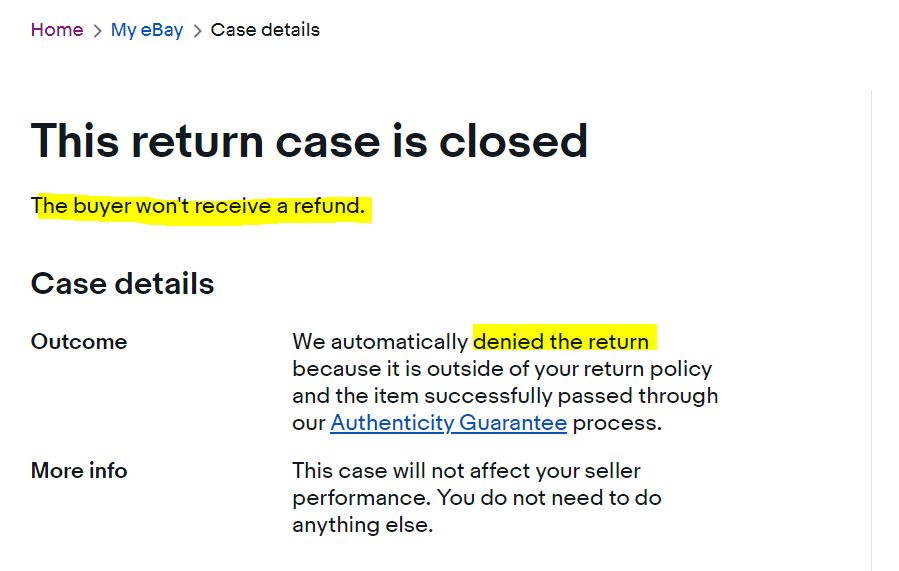
Is It Cheaper to Sell on Amazon or eBay?
Seller Fees
Amazon
Amazon sellers must pay certain fees to sell on Amazon’s marketplace. First, you must choose a selling plan, Individual or Professional, to sell on Amazon. If you choose the Individual plan, you will be charged $0.99 per item you sell. With the Professional plan, you pay $39.99 per month, and there is no limit on the number of items you sell. The other most common fees are referral fees and fulfillment costs.
When choosing a selling plan, there are a few things to keep in mind. The Individual plan is the most cost-effective plan if you are new to selling on Amazon and don’t plan on selling more than 40 items a month (yet!).. However, the individual plan doesn’t come with access to some of Amazon’s advanced selling tools, such as their advertising tools.
The Professional plan is for Amazon sellers who are serious about growing their business. There is no limit on how many products you can sell on Amazon, and you also gain access to powerful tools that help you manage inventory, advertise, report, and more!
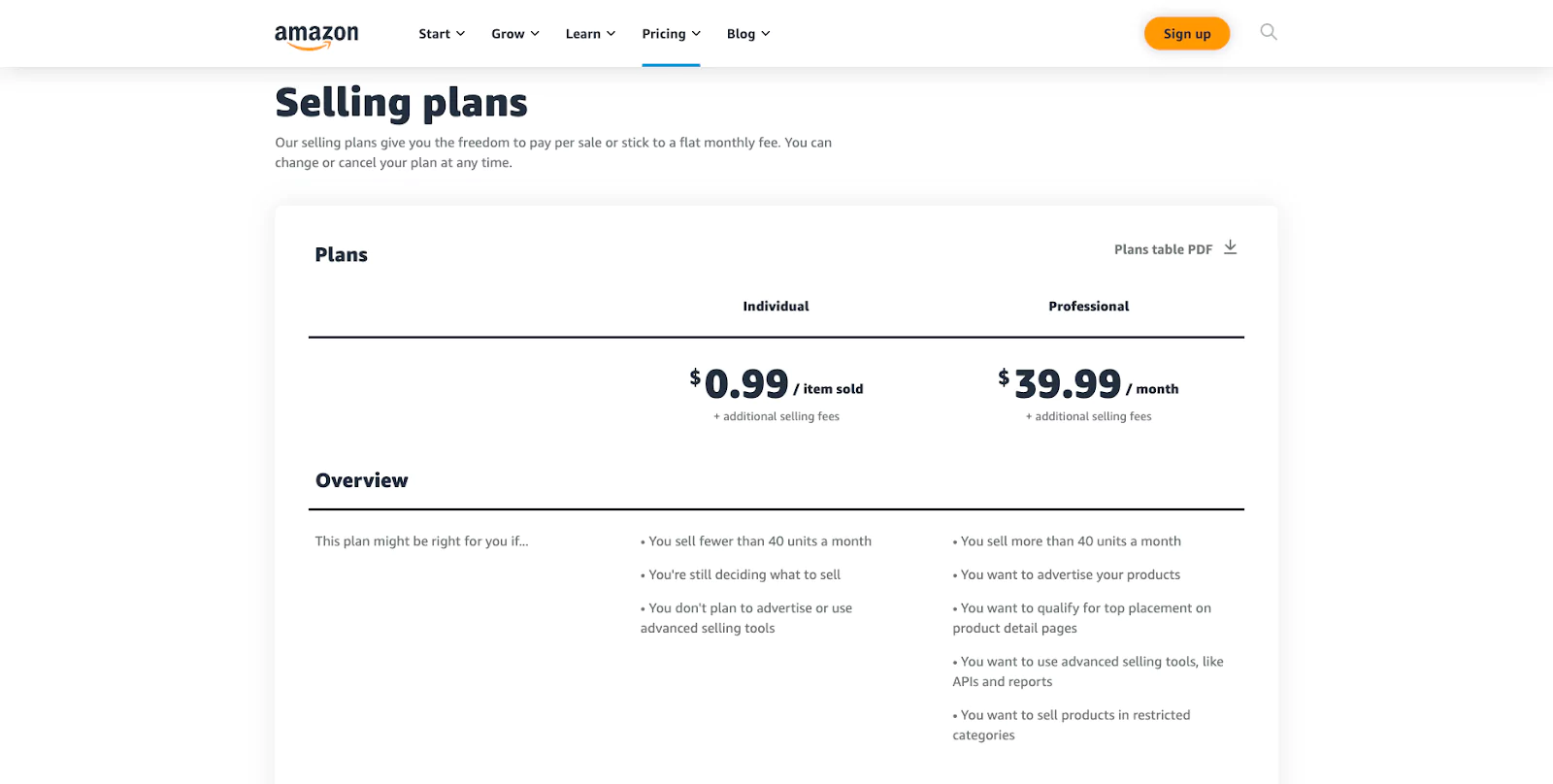
Amazon charges a referral fee for every item sold. These fees are a percentage of the item’s sale price and vary based on the category in which the product is listed. Below are screenshots of the referral fees for each product category. Amazon uses referral fees to cover the cost of providing a platform for sellers to reach customers and the various services and features that Amazon offers to both buyers and sellers.
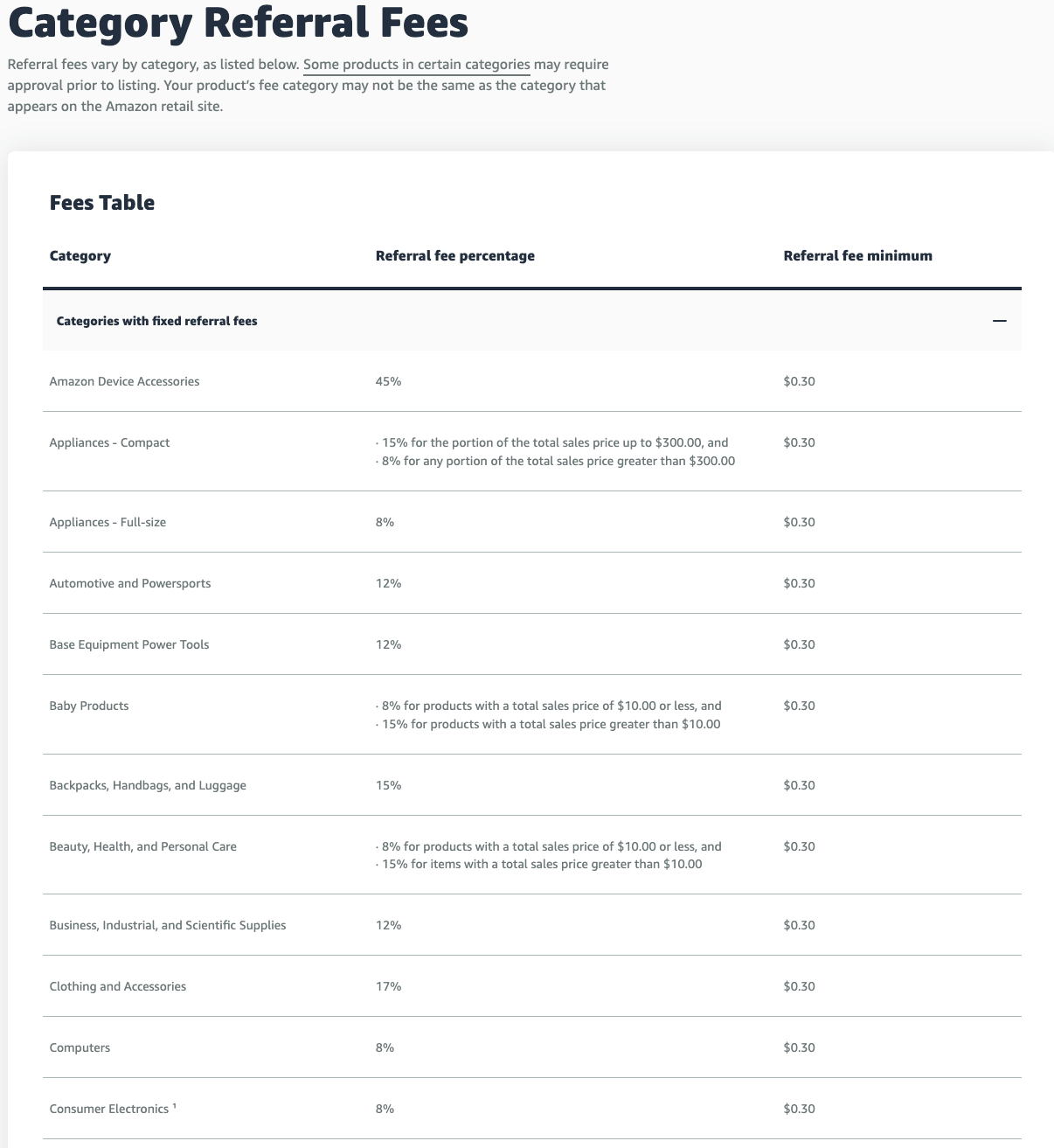
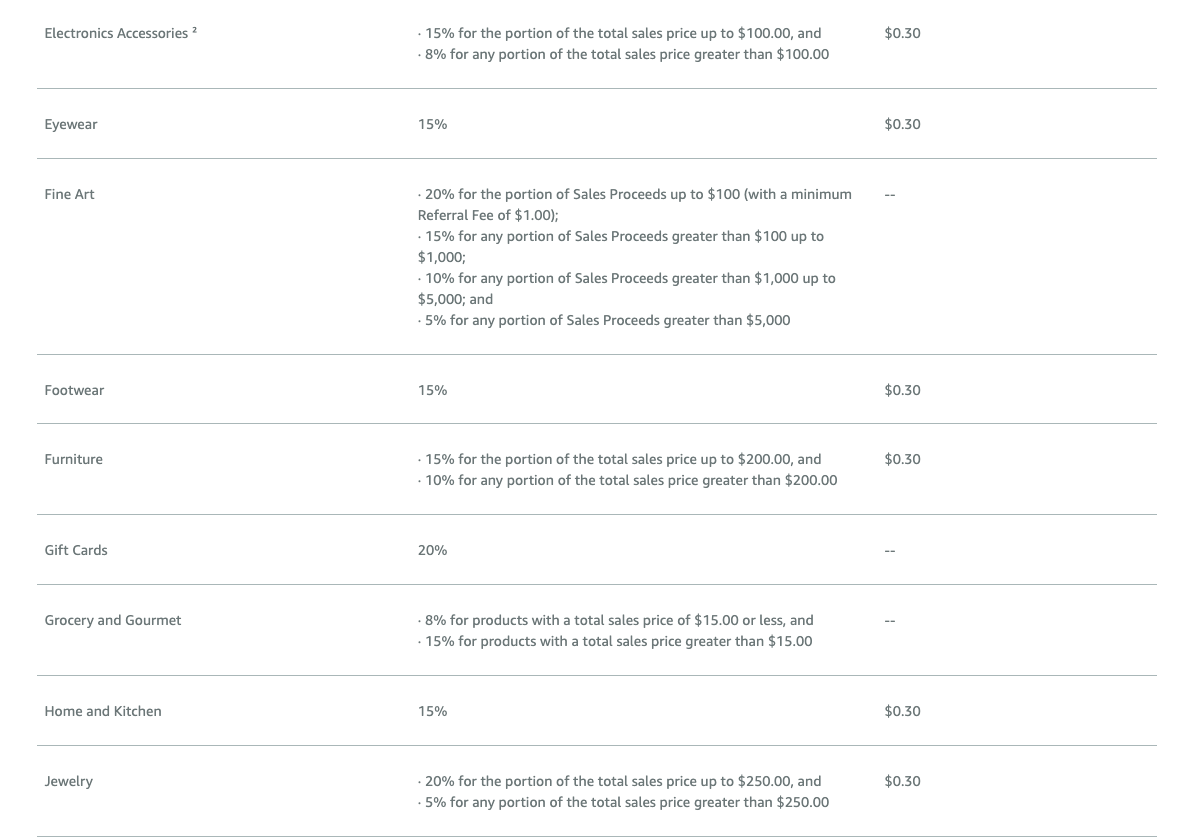
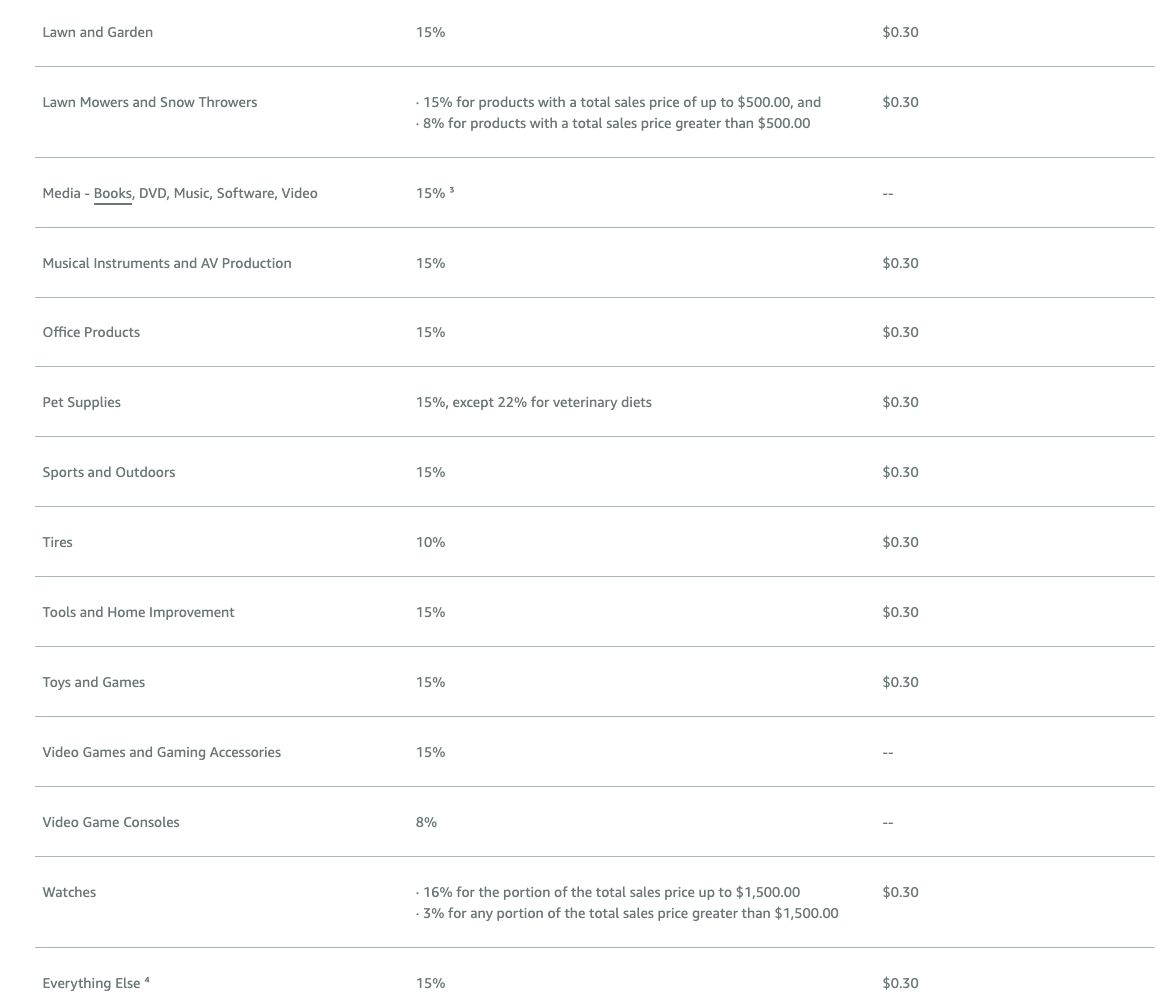
In one of my Amazon accounts, which has made about $100,000 in sales so far this year, the commission Amazon took represented about 15% of my total sales, as you can see from my Helium 10 Profits screenshot below.
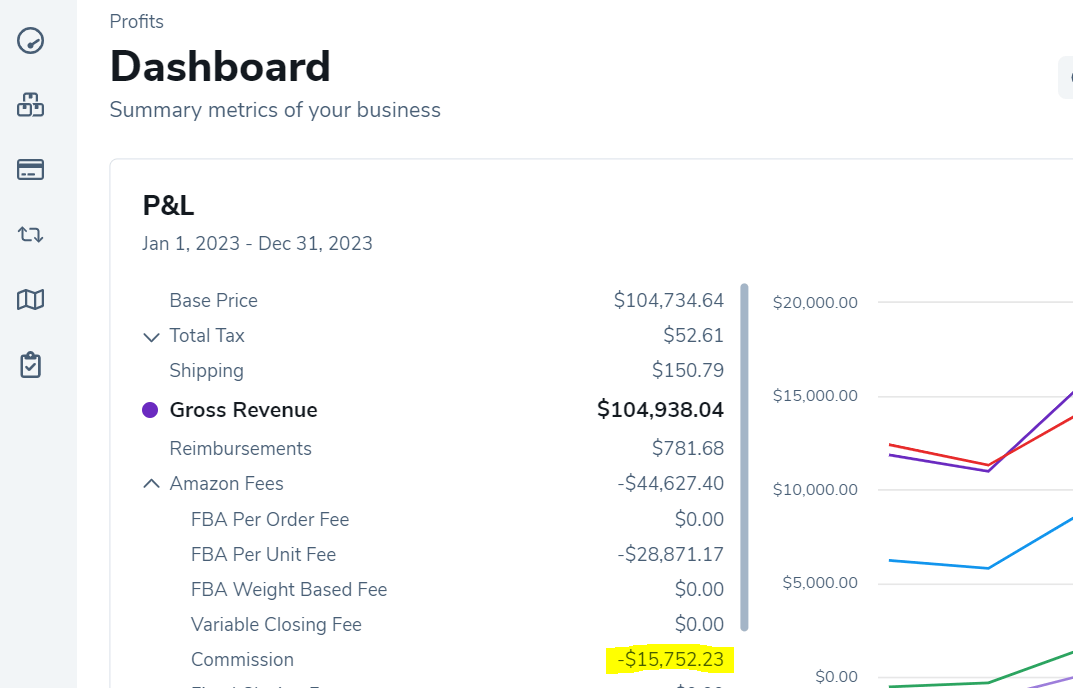
eBay
When selling on eBay, sellers must pay two main types of fees: an insertion fee and a final value fee. Insertion fees, aka listing fees, are charged when a seller lists an item for sale on eBay. The first 250 listings per month are often free, but additional listings will incur a listing fee ranging from $0-20. The fee varies depending on the category and format of the listing (e.g., auction-style or fixed price). Final value fees are paid by the seller when an item sells. The fee is a percentage of the total sale plus $0.30 per order. In the images below, you can see how much the final value fees are for each product category.
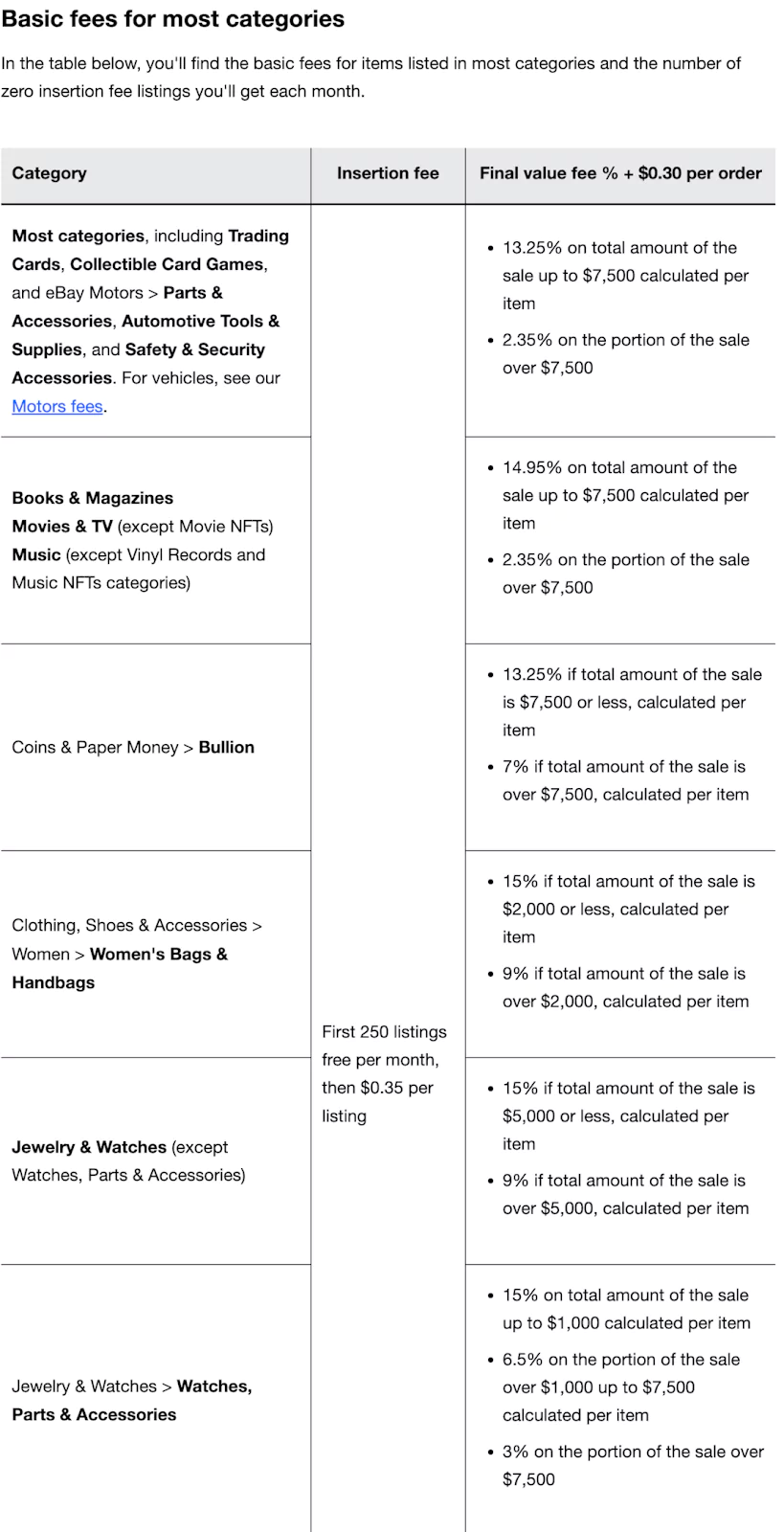
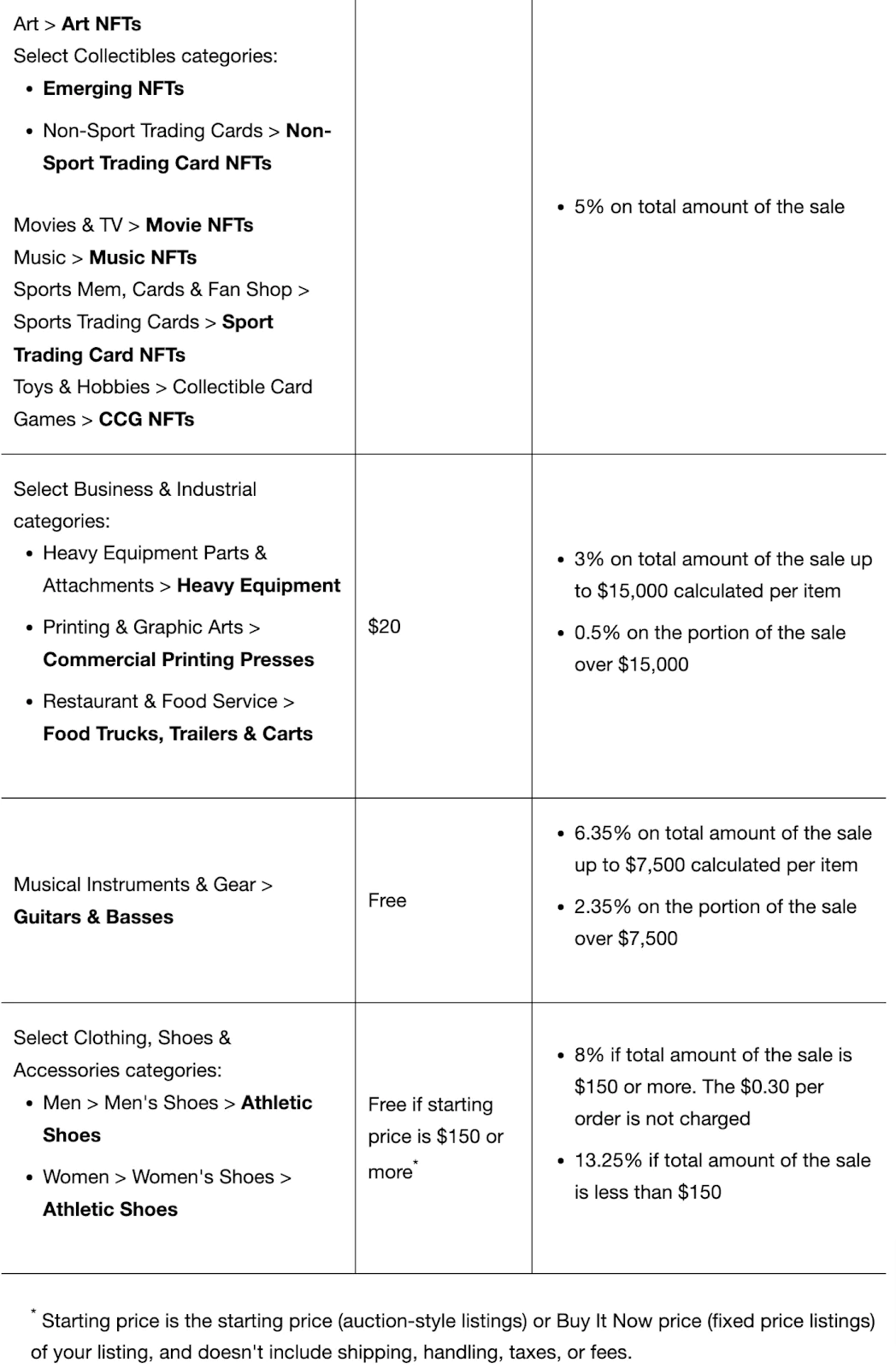
For most sellers, eBay fees are usually less than on Amazon. For example, as you can see in the screenshot below, my 2023 fees only represented 12.8% of my total sales, with almost all of it being final value fees, only 2% being insertion fees, and another 2% in international fees.

PPC Costs
Amazon
Amazon PPC, or Pay-Per-Click advertising costs on Amazon, can vary significantly based on factors such as the product category, keywords, competition, and bid strategy. The cost per click is determined through a bidding system where sellers compete for ad placements, and the price you’re willing to pay for a click on your ad affects your ad’s visibility. The advantage of running ads on Amazon is that you can sometimes bid your way to the top spots in the search results.
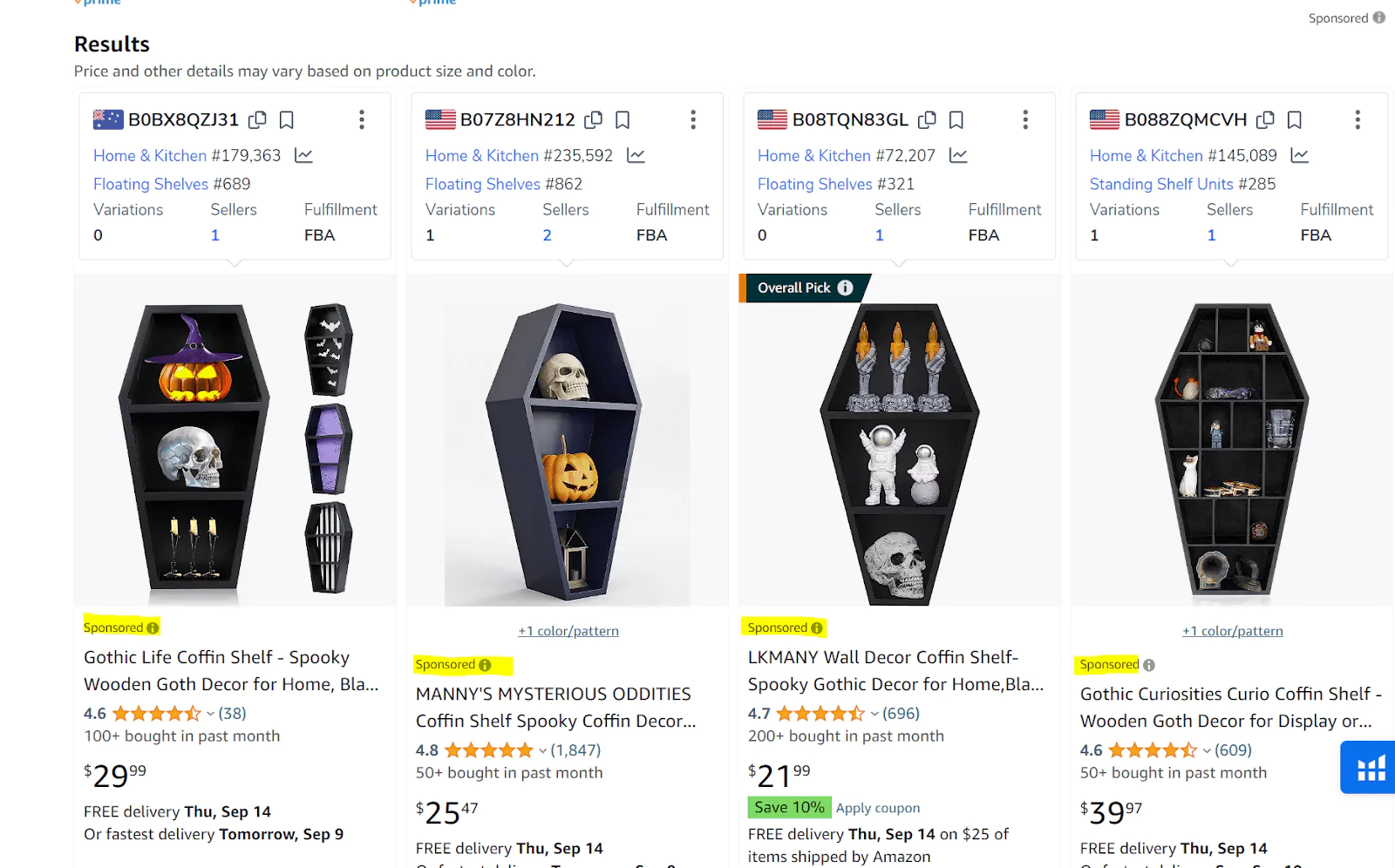
Popular and competitive keywords typically have higher CPCs, while niche or less competitive keywords may have lower costs. The key to managing Amazon PPC costs effectively is understanding your target audience and selecting relevant keywords that align with your product. Optimizing your ad campaigns, monitoring their performance, and adjusting your bids accordingly can help you strike the right balance between cost and visibility. Tools like Adtomic can help save a lot of time by preventing you from having to download manual reports and crunch numbers.
It’s important to note that Amazon PPC is a dynamic system, and costs can change over time based on market trends, seasonal fluctuations, and competition. Monitoring your campaigns regularly and making data-driven adjustments can help you optimize your advertising budget and maximize your earning potential on the platform.
eBay
Like Amazon, running ads can gain top spots in eBay search results.
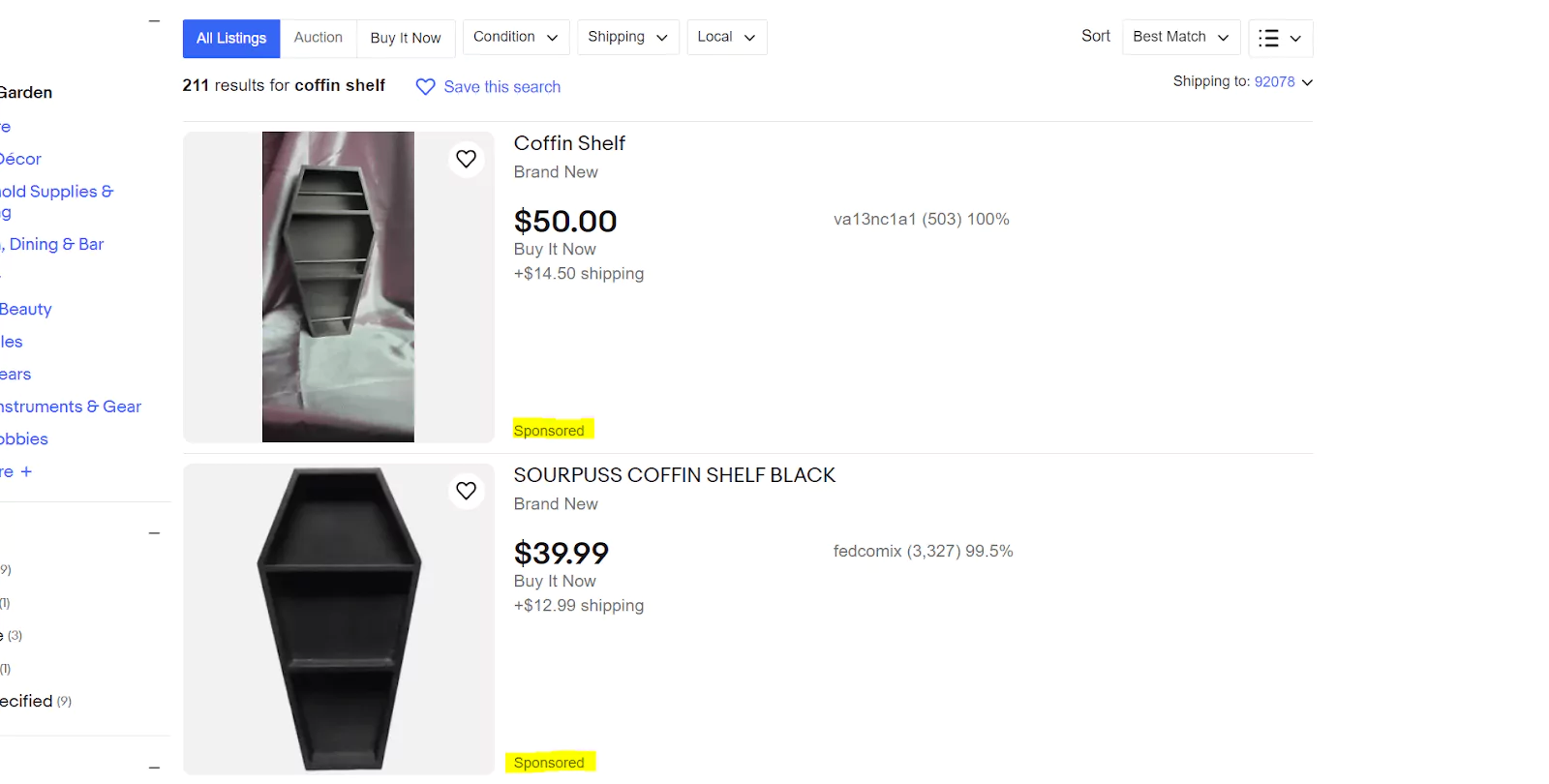
It has been said that using PPC on Amazon is imperative; however, that is not the case on eBay. I myself have not run one ad on eBay for the entire year and have done just fine without it.
There are fewer advertising options on eBay; however, they have been building out their platform in the last year to have more advanced options that allow you to use some of the targeting options that Amazon has.
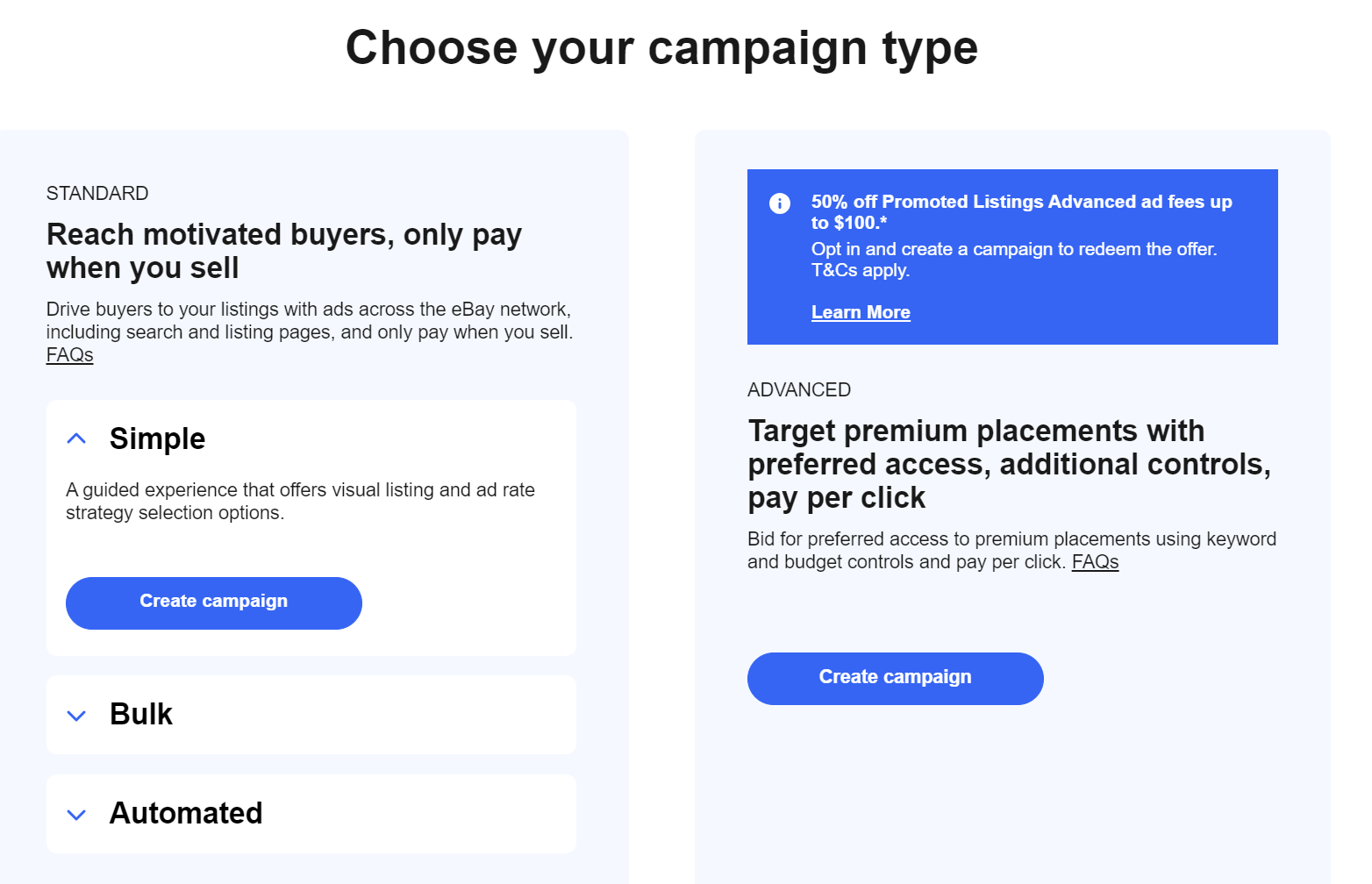
Which Platform is Easier to Sell Through?
Amazon Seller Central
Managing your Amazon business on Amazon Seller Central offers a user-friendly and efficient platform for sellers to oversee their operations. With its intuitive interface and comprehensive tools, managing your Amazon business becomes seamless.
Another feature that makes managing your Amazon business on Amazon Seller Central easy is the ability to track and analyze sales performance. The platform provides detailed reports and analytics, giving sellers valuable insights into their sales, customer behavior, and product performance. This data can be used to optimize marketing strategies, identify popular products, and make data-driven business decisions.
Amazon Seller Central offers robust customer service tools, making communicating with customers and addressing their queries and concerns easy. From managing customer inquiries to handling returns and refunds, the platform streamlines customer service processes and provides sellers with a positive buying experience.
Seller Central’s biggest advantage is the advanced analytics it offers through programs such as Search Query Performance, Brand Analytics, and more. These programs can give granular data points such as how many customers clicked on your product after seeing it in the search results for a certain keyword.
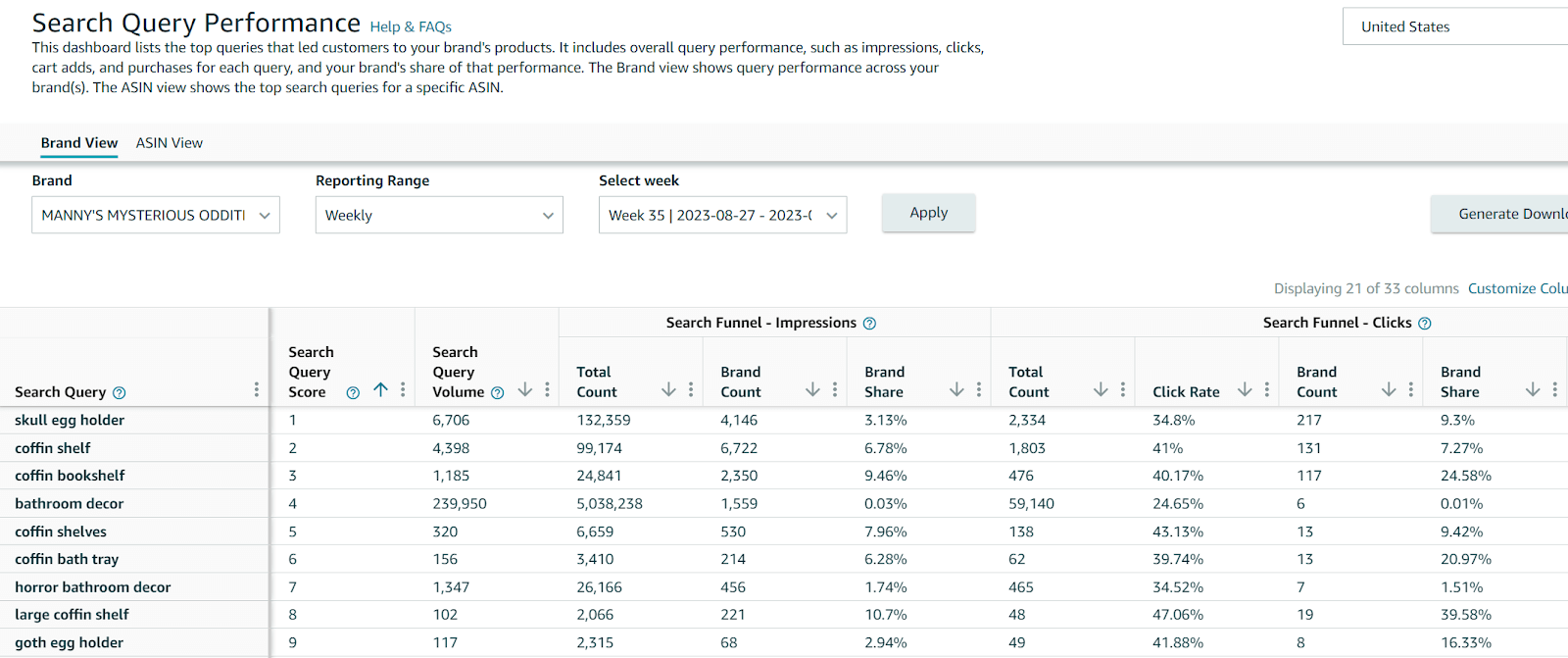
eBay Seller Hub
The eBay Seller Hub has evolved over the years and has everything an eBay seller might need, including overviews, order pages, active and inactive listings, store management, research, eBay selling fees, and more.
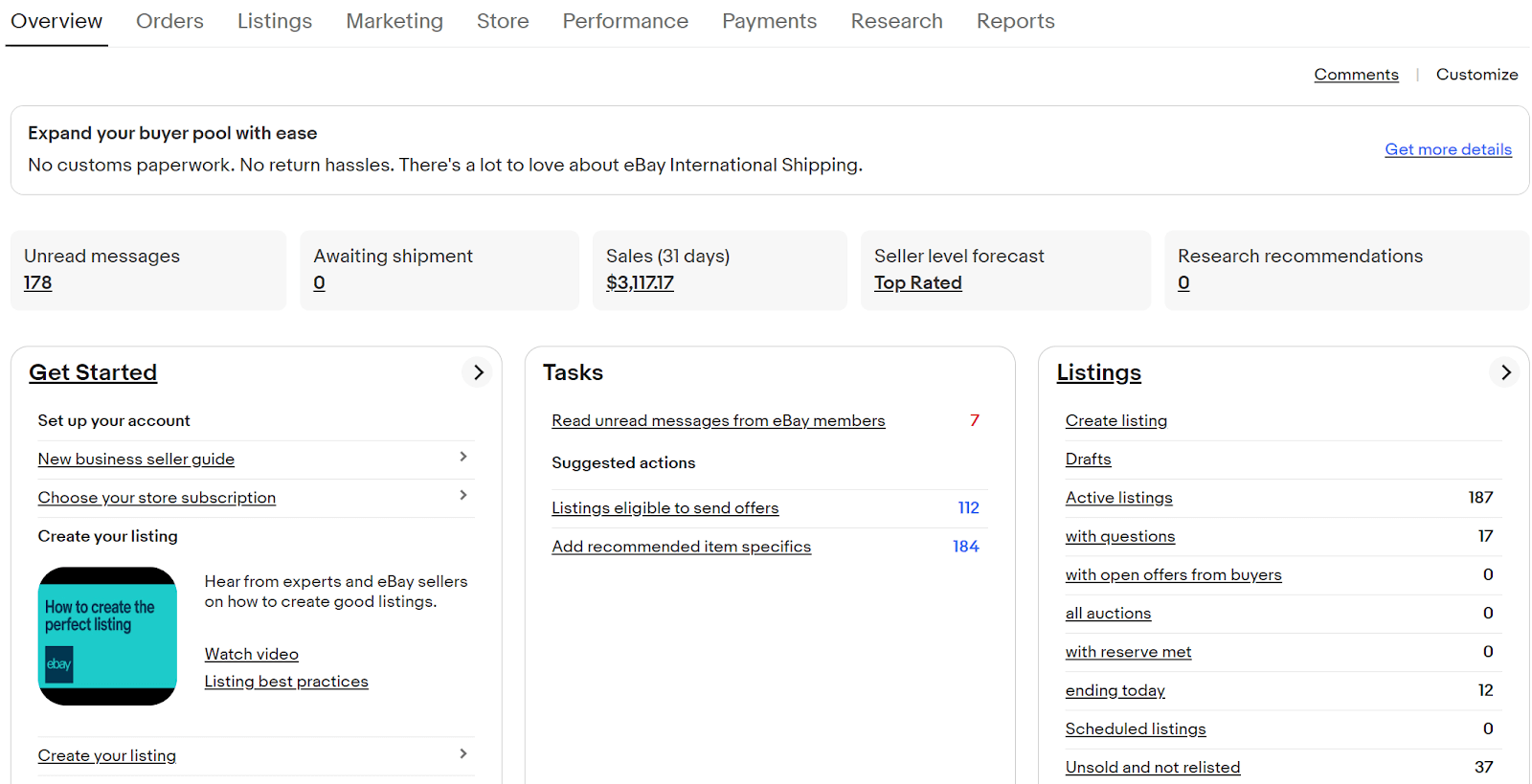
One difference between seller central and seller hub is that, for the most part, the buyer and seller accounts are completely separate in Amazon. However, in eBay, both of these are on your same “my eBay’ menu, so sometimes it might be a little confusing.
Like on Amazon, through your seller hub, you can purchase shipping for your orders at discounted rates via eBay. However, eBay offers very little in terms of keyword details and analytics. You have no visibility into what searches buyers are using to find your products.
Another tedious task for some is the need to renew listings. However, eBay has the unique function of offering auctions. This is one of the most popular ways for buyers to purchase on eBay…via timed auctions that they can bid on. Amazon does not have anything like this.
Nothing beats the thrill for some to perhaps get a product at a cheap price because no one else is bidding on it. While this is great for buyers, as sellers, you run the risk that your product will sell at a price way below what you wanted for it. The counterpoint is that unlike on Amazon, where things are fixed price, if there is a lot of demand for your product, your sale price could even be much higher than you expected.
Pros and Cons of Selling on Amazon and eBay
Amazon
Amazon offers a diverse array of product types for sellers to capitalize on. The platform caters to a wide range of consumer needs from electronics and apparel to home goods and books. This includes physical products and digital goods like e-books, music, and software. Amazon has a much more formal product catalog than eBay. When you browse on Amazon, it feels like a well-structured online store, with different sections showing trending products, deals, vast product categories, and more.
Generally, the products that are sold on Amazon are in new condition. While it is possible to buy/sell used items on Amazon, it is much more common for products to be new.
eBay
Since eBay was launched, it has been known as a marketplace for people to buy and sell any product or item. However, they lean towards being one-off items, collector’s items, historical pieces, or fine art. eBay has more of a “garage sale” feel. In contrast, Amazon has a more structured product catalog feel. While many products on eBay are in ‘new’ condition, people prefer to use eBay for second-hand goods and go to Amazon to buy new products. Unlike on Amazon, where multiple sellers can sell on the same listing, on eBay, each listing is unique to one seller. There is no “piggybacking” on listings like on Amazon, which can be a pro or a con, depending on your point of view in this Amazon vs eBay contest.
Why Sellers Might Consider Selling on eBay
A simple reason for selling on eBay, if you are selling on Amazon, is that if you don’t sell your products on eBay, then someone else probably will. Dropshippers will find products not sold on eBay and then list them.
If they make a sale, they purchase your product retail from your store and ship it to the customer. Instead of that dropshipper making a profit, it would be much better if you listed it yourself, then saved yourself the Amazon fees and made the sale directly to your customer.
Here is an example of someone drop-shipping our coffin shelf listing. We have it listed on Amazon for 24.99, and they are selling it for 35, so it’s hard to imagine how they are even breaking. If we sold it for 27.99, we would still be making much more profit than on Amazon, and at the same time, an eBay buyer is more likely to buy it at that price.

Conclusion
Selling on eBay vs. Amazon has many similarities and differences. If you are selling used goods or vintage one-off items, eBay is by far the better option since eBay sellers can tap into the higher demand for these items on that platform. Third-party sellers, on the other hand, should look into starting on Amazon first.
It’s hard to say there is a winner in the Amazon vs. eBay debate. They are completely different platforms for different kinds of buyers and sellers. EBay and Amazon can help your e-commerce business reach customers you might not have if you only sold on your website. I sell on both platforms and will continue to do so!
Frequently Asked Questions
Achieve More Results in Less Time
Accelerate the Growth of Your Business, Brand or Agency
Maximize your results and drive success faster with Helium 10’s full suite of Amazon and Walmart solutions.

